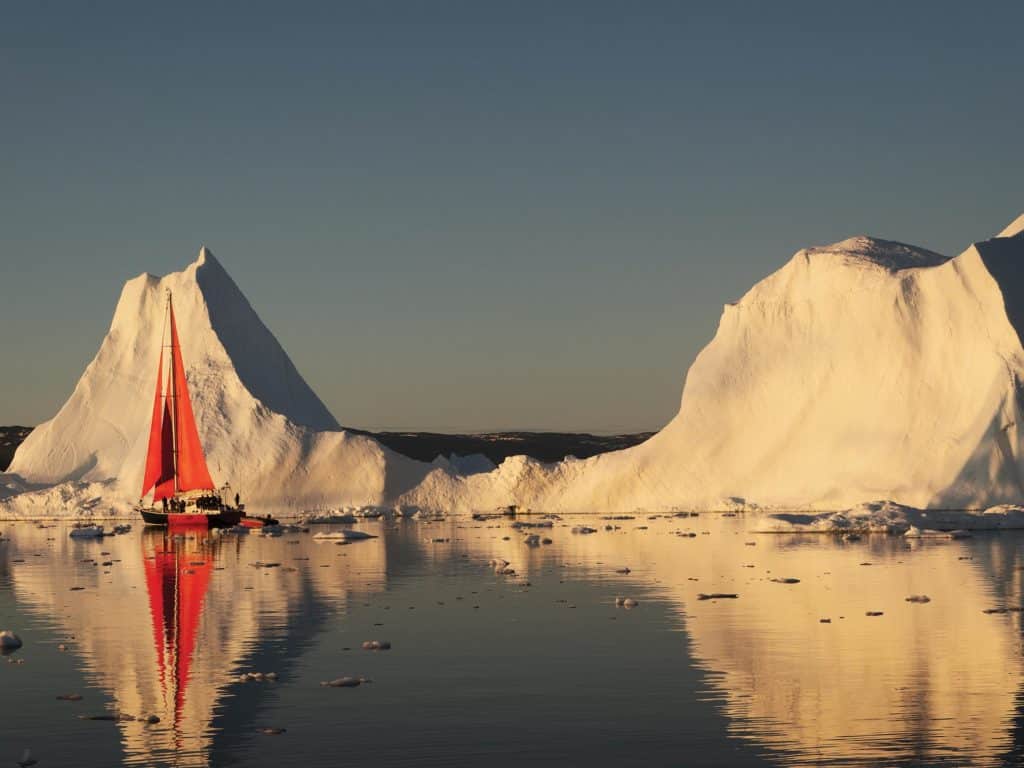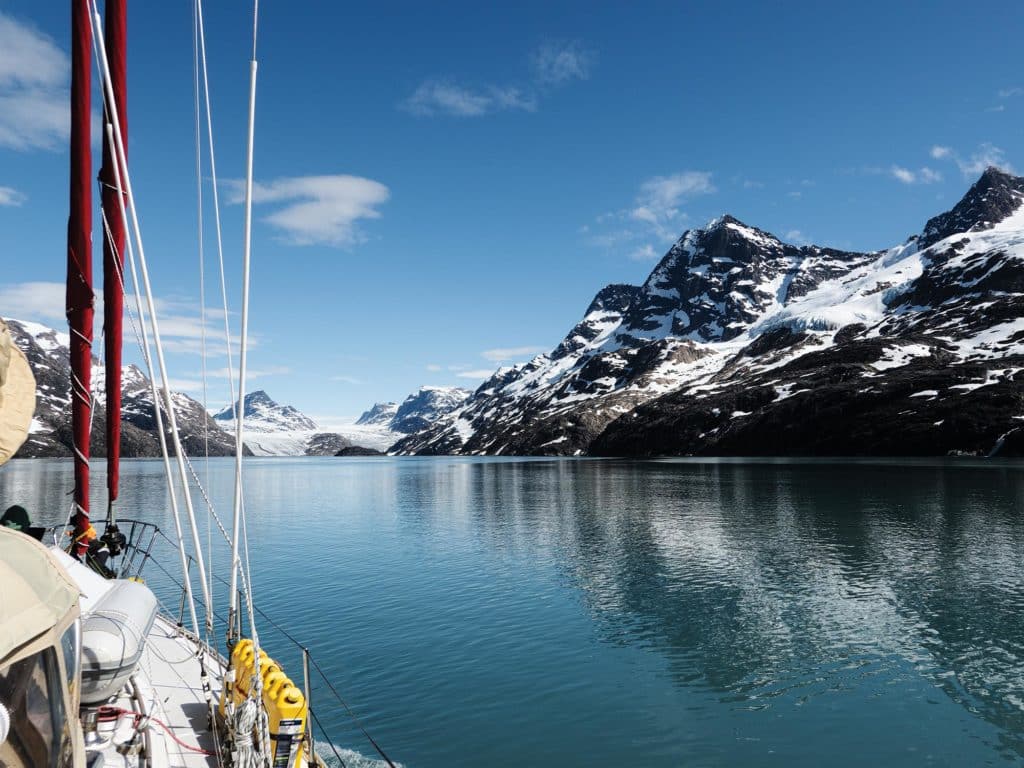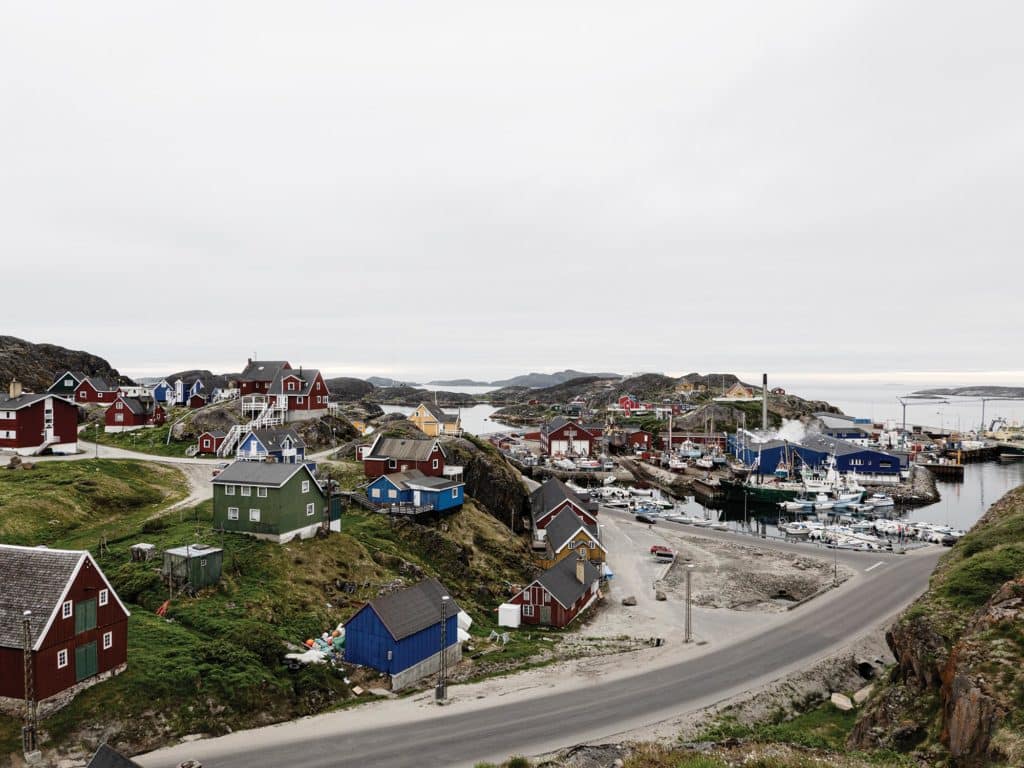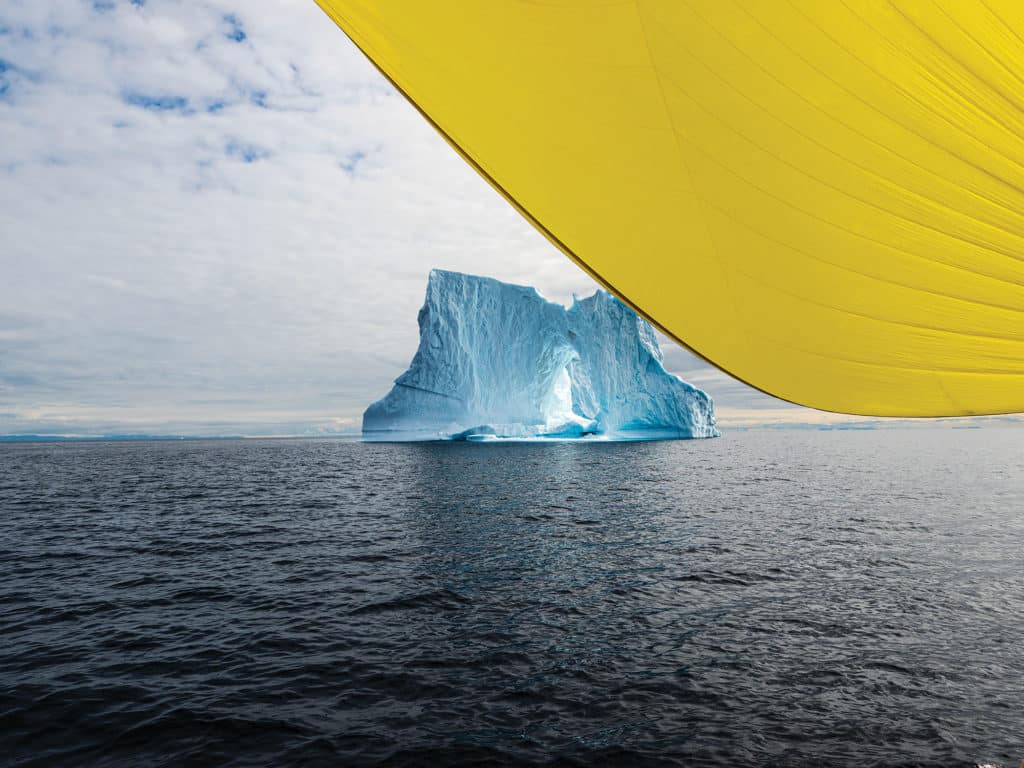
I had always imagined, looking at world globes and navigational charts, that the surface of the earth would somehow feel different the farther north you went. That perhaps gravity would pull you at a slanted angle, or that the horizon would look narrower as the longitude lines drew closer together. I imagined one would get shortness of breath or vertigo as the polar regions were approached.
Not surprisingly, as far as those things go, everything seems the same even several hundred miles north of the Arctic Circle. The horizon is as expansive as ever, water stays level in a glass, and my head is not swimming from lack of oxygen.
What is different, though—shockingly, disconcertingly different—is the perpetual daylight. Long before Polar Sun, the Stevens 47 we’re cruising in Greenland, reached the Arctic Circle, we had left the night behind. The last darkness we saw was when we left Flowers Cove, in northern Newfoundland, at 2 a.m. to catch the downtide to Mary’s Harbour in Labrador. After that, with the bows pointed north into the Labrador Sea, though the sun would briefly set, the twilight endured until it rose again just a little to the right of where it had gone down.

It was good that it should be so because there are icebergs about in late June in the Davis Strait, and though we didn’t see many, the ones we did see made us grateful for the light and a sharp lookout. There was little else to look out for, though. Between putting Labrador astern and fetching Greenland ahead five days later, we saw only one coastal ship between each place. It was a surprisingly benign passage at first, given what I’d been led to expect about the Davis Strait. For three calm and pleasant days, we alternated between the engine and the “whomper”—a huge, yellow asymmetrical spinnaker—and congratulated ourselves on our luck.
As luck will, it ran out two days from Nuuk, the capital of Greenland. From just north of the aptly named Cape Desolation, we were treated to a strong following breeze with some confused cross swells that slammed the boat onto its beam ends every so often, and made heavy weather for the Hydrovane self-steering unit. It was a finicky business, tuning the vane, the deeply reefed sails and the helm so that everything would work together, but when we finally had it sorted, Polar Sun scooted along at 8 and 9 knots for hours on end without us touching either the wheel or the sheets. It was a good thing too because one of our number was down for the count, hugging a gently sloshing bucket of vomit in his bunk. The rest of us felt lucky if we could boil a kettle in the violently slamming boat to make ramen or coffee in a thermos without burning ourselves.
Even in the inner harbor of Nuuk, the wind was shrieking along the quays, making the boats tug restlessly at their warps. As is the custom in these parts, one that we got used to only with time, we rafted up to the first convenient tugboat and turned in. When you think about it, rafting up, especially to something big, is far preferable to grinding up and down a grubby commercial bulkhead with 15-foot tides giving your spring lines and fenders a workout. Better to let them deal with the headache of the inside tie, and ride up and down tied comfortably short.

Besides, it’s a great way to make new friends. Farther north, in Ilulissat, we wound up in a six-deep raft-up, which made for quite the jolly social scene as everyone crawled over each other’s boats to get to and from the fish wharf.
I had expected Greenland to be much like northern Newfoundland and Labrador in the way of food and groceries, which is to say more packaged food than fresh, and more burger-and-fry joints than other sorts of restaurants. And once again, my imagination was incorrect. Being still heavily Danish, the grocery stores are crammed with European as well as Greenlandic foods, and best of all are the ubiquitous bakeries full of fresh bread and pastries. While the restaurant prices might raise the eyebrow of the cruiser accustomed to street tacos in Mexico or pupusas in El Salvador, the food is quite good, and we tried musk ox and reindeer and whale, as well as codfish and halibut. There is a bent toward the gourmet in the preparation and presentation that initially struck me as out of place in what should have been rough-hewn fishing towns, but that was just me projecting preconceived notions again.
I had no notions or ideas about what to expect of the coast between Nuuk and Disko Bay, nor could I have imagined the snow-girdled mountains that rise straight from 100-fathom fjords to 3,000-foot peaks. And not just once, mind you, but everywhere you look, for days and days as you cruise north. There is an inshore passage that begins about 50 miles north of Nuuk, and treads a winding, sheltered path behind coastal islands and through narrow, winding tickles scarcely twice the beam of the boat. This route crosses many fjords, and you can pick one at random and explore—up, up, along water ever more aquamarine, until at the head, the glacier can be seen, pressing a wall of ice toward the water and sending frozen chunks out along the silty glacial stream.

We alternated between anchoring in remote coves and tying up to commercial docks in villages. It’s luxurious, with perpetual daylight, not having to hurry to get somewhere before dark or to get up before dawn to catch a fair tide. But it’s terrible for the sleep schedule, and your daily rhythms go all sideways. Breakfast at noon? Why not, if the next boat in the Sisimiut raft-up was partying till 3 a.m. and heffalumping back and forth across your deck in clunky sea boots. Coffee at midnight? Why not, if you’re still in brash ice, three hours from Aasiaat, and calving icebergs have strawed your path with growlers and bergy bits. We eventually found it preferable to arrive and tie up after working hours—there was less bustle in the harbor, and whomever we rafted to was unlikely to be about to cast off and leave.
Aasiaat is on the southern shore of Disko Bay, the center of Greenland’s tourism industry. At the back end of the bay, a river of ice 30 miles long empties its bergs into open water. From there they fan out, drifting slowly with wind and tide so that, as far as the eye could reach, as we sailed north toward Disko Island, huge mountains of ice floated in solemn silence on water 200 fathoms deep. After stops at the secluded Whale Fish Islands and in Godhavn, we finally reached the real prize of Disko Bay.
Situated at the very mouth of the fjord from which all the bergs issue, Ilulissat is guarded by a barrier of floating ice chunks that looks impenetrable when approaching from seaward. This band of concentrated ice was 5 miles wide when we crossed it, and extended for dozens of miles both north and south. Bergs of all sizes floated amid myriad smaller pieces, but an intricate path could be woven between them, avoiding all but the smallest brash. Even when the way ahead looked shut, if you carried on, there was always an opening.
All adventure has some risk, and if we were going to sail into the Northwest Passage, ice was one danger we were going to have to get used to.
Back in the States, people had shown us diagrams of the closest safe approach to ice, which had proved ludicrous already in the narrow tickles south of Aasiaat, and were now simply laughable as we passed an arm’s length from hundreds of bergs of all shapes and sizes. Was it safe? Who knows—it’s a long shot whether a berg will calf or roll in quiet water while you’re next door—but what choice did we have? All adventure has some risk, and if we were going to sail to Baffin Island and from there into the Northwest Passage, ice was one danger we were going to have to get used to.
We couldn’t have chosen a better place to acclimatize to ice than Ilulissat. More days than not, smaller bergs come bumbling into the harbor with the tide, and often, as they drifted back out, we had to direct them away from the boats with some special ice poles I had made. They were mostly harmless in the calm water of the harbor, but a passing wake would set the smaller ones knocking on the hull and have us out with the ice poles again.
Beyond Ilulissat and Disko Bay, the coast of Greenland stretches northward, ever more remote and frozen, and is visited only rarely by cruising sailors. Farther yet, it becomes a land where both sea and air are freezing all year long, and even icebreakers with supplies for the handful of settlements are seasonal and occasional at best.
I’ll cruise that direction someday, perhaps, but for this trip, our northing in Greenland was done, and Polar Sun’s path lay to westward across Baffin Bay, and from there into the winding paths of the Arctic Archipelago.
While his wife conspires to turn him into a chicken rancher, Ben Zartman runs away to sea whenever he can. When not delivering sailboats, he runs a rigging business out of his garage, splicing line for local racing fleets.









